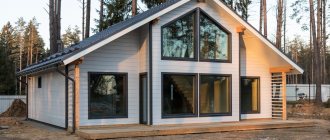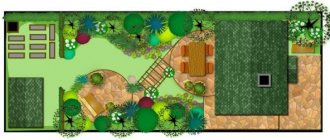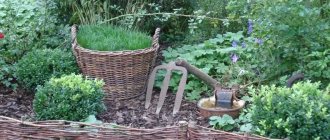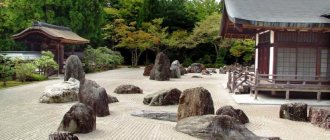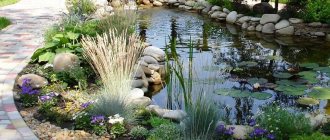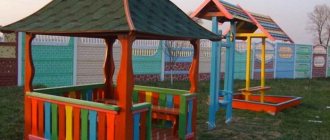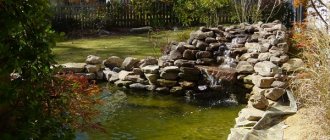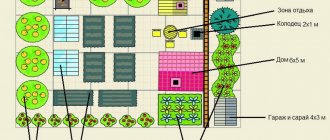How to decorate a garden in winter
If you have thought about how to decorate a garden in winter, then you already know that the term “out-of-season plant arrangements” often used by gardeners, as a rule, excludes winter time by default. If you are not one of the summer residents who appear on their plots with the first rays of the April-May sun, then it is useful to pay more attention to the winter decoration of the garden.
The easiest way to imagine exactly how the garden will look in winter is to look at the site plan on a piece of paper
.
If you are closer to a living picture, then there is no better time than early spring. , uneven landscapes, turns of paths, clearings and edges
are most open for exploring .
The garden most immersed in summer greenery seems deserted after a long hibernation, because even the cereals and perennials left in the fall are thoroughly crushed by the melting snow.
In addition, all the unsightly aspects of economic activity are exposed, for example, a compost bin, shelters on roses, equipment that has not been removed since the fall
. In such conditions, it becomes clear what exactly needs to be hidden from view, and what, on the contrary, should be emphasized.
Trees and shrubs
Plants with beautiful trunks and branches, similar to a skeleton, appearing after autumn and pleasing the eye until a new generation of leaves bloom, give the winter garden an extraordinary openwork
. Such plants cannot hide anything behind a mesh of translucent crowns; they are inconspicuous, but they decorate the garden well in winter in an already established landscape.
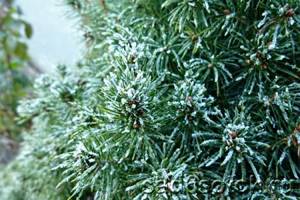
Decorating the winter garden with trees. A variety of coniferous plants with broom variations of needles represents almost the entire color palette
However, there are also pleasant exceptions when the garden or a separate part of it consists only of deciduous trees, shrubs and beautifully fading perennials, and this does not interfere with its integrity. For emphasis in such cases, spectacular forms of trees are used, for example, weeping forms of plants such as birch, rowan, larch, willow
.
Large shrubs such as bladderwort, barberry, dogwood, and honeysuckle also become the main ones. The role of filling plants is played by low spirea (usually varieties of Japanese spirea) and dried bushes of astilbe, Fassin's catnip, forest sage, hyssop, and anafalis left in the fall.
Honeysuckle, euonymus and Kuril tea are famous for their rather gnarled shoots with heavily peeling, light beige bark. Shrubs with an abundance of thin branches, like spirea sulfur, create a thin, smoke-like curtain. They are designed to soften the overly saturated colors of other plants, bringing them closer in tone to the overall muted palette of the garden.
Photo report on the design of the winter areas of the kindergarten
Bayanova Yulia Vladimirovna
Photo report on the design of the winter areas of the kindergarten
The most magical time of the year has arrived - winter. In winter, you can transform the kindergarten site into a fairy-tale kingdom with snowmen, huts, labyrinths and even snow dragons. Educators need to think through everything. Daily walks should be beneficial for children's development. To ensure high-quality organization of walks in winter , it is necessary to create certain conditions: clear the area of snow , build buildings for the development of basic movements (walking, running, jumping, throwing)
.
And how much fun, joy and pleasure children get from playing snowballs, sledding, and sliding down ice slides! Decorating winter areas is not an easy job , requiring a lot of physical effort. We involve parents to help: they bring water, snow, and help clear the area after snowfalls and blizzards.
Parents with great interest and pleasure are mastering new technologies for working with snow, making their suggestions... The purpose of designing winter areas is:
— maintaining traditions in the team and intensifying collective creative activity, developing creative abilities, nurturing aesthetic taste;
— creating favorable conditions for educational work with children on walks in winter , increasing the physical activity of pupils in preschool settings.
This year, the administration of the kindergarten , instead of the traditional exhibition “Santa Claus’s Workshop,” organized the event “Do-it-yourself New Year’s garland for decorating the winter area .” And I must say that the parents showed remarkable imagination and creative abilities. Everything came in handy: plastic bottles, old CDs, disposable tableware, polystyrene foam, yarn - transformed into snowmen, symbols of the year, bells, flowers, etc.! I cannot help but share the results of the joint work of parents and educators.
Also, not only verandas were decorated, but also tree branches. I liked bullfinch birds made of wool, like apples.
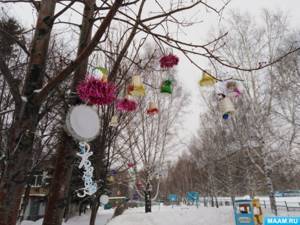
Among the snow figures, the most popular this year, for obvious reasons, were pigs.
But there were other design : Christmas trees, snail, boat, Russian oven, octopus, labyrinths. I’ll immediately make a reservation about the use of paint - it’s diluted gouache. Standing figures were allowed to be painted, but recumbent ones were not - to prevent children from soiling their clothes. Wool, fabric, balloons, and colored pieces of ice frozen in disposable cups were also used.
Thank you for your attention!
Colors in design
Although black and white versions of the winter landscape
sometimes there are quite a lot of adherents, the winter garden can and should be colorful.
Golden, yellow, reddish, crimson, steel-blue and dove-violet tones are not a winter fantasy, but a reality
. To decorate your garden in winter with multi-colored paints, use a variety of coniferous plants with different variations of needles; various varieties represent almost the entire color palette, with the exception of red tones, which are provided by dera shoots, fruits of barberries, rowan berries, viburnum, etc. The main thing is not to overdo it with the number of color spots, so as not to get scattered bright strokes instead of a harmonious picture, standing out loudly on the white snow.
Shrubs with neutrally colored dense crowns and green conifers are excellent separators and helpers in constructing tonal combinations.
For example, white derain
has very smooth and shiny, depending on the variety, crimson or red shoots. Against the background of spruce trees, next to Japanese spirea and creeping juniper, it looks bright and festive. A colorful bonfire of shoots is visible from afar and attracts the eye, relegating companion plants to secondary roles. The same variety, also against the backdrop of a spruce hedge, but surrounded by gray spirea and fir, muting its color attacks, and tree hydrangea, with large beige balls of inflorescences that attract attention, looks different. Note that the lacy bushes of Japanese spirea in both variants carefully maintain the balance between the hard whiteness of the snow and the dense wall of the hedge.
Get bushes with red branches
Plant plants with colorful shoots, such as red turf. Over the course of a season, its branches change color from light green to dark purple.
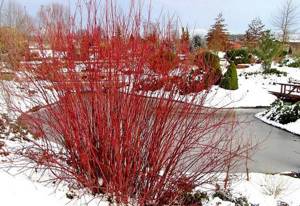
Red derain

Dogwood brilliant
Shrubs with decorative bark are good because they decorate the area not only during flowering, but also after it ends. With the help of these plants you can create extraordinary landscape compositions.
Sound design
A warm, strong wind, which usually comes with a thaw, is no less characteristic of the winter months than the frosty crunch of snow underfoot. It is capable of not only howling in pipes and whistling in the ears, the music of the wind can also be heard with the help of cereals
. The rustling of dried panicles and ears of corn will refresh the notes with a charming good news, diluting the monotonous roll call of drafts.
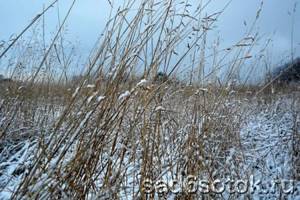
To diversify a winter garden with coniferous plants, just plant a couple of tall grasses
Bending with tight bowstrings to the very ground during gusts and tirelessly straightening during a lull, tall grasses enliven the winter garden until the snowfalls of the second half of winter break their stubborn disposition. To simply diversify the composition, it is enough to plant a couple of tall grasses, but for the sound arrangement of the garden you will need about a dozen specimens.
Beautiful winter verticals are produced by reed grass, miscanthus, Spartina comb, and molinia.
. Pay attention to the shape and density of the cereal panicles. Miscanthus panicles are the densest and most powerful in appearance, real heavyweights. Beautiful and graceful is the molinia “Karl Foerster” with curved arches and long peduncles.
The spikelet has sparse and not very tall ears, but its yellowish-bluish dry leaves compensate for this deficiency.
Heat-loving species that require wintering under cover, for example pennisetum, Buchanana sedge, are not suitable for this purpose. Low altitude can also be a serious obstacle to participating in a winter fashion show.
Fruit and berry decoration
Bright or simply beautiful fruits are especially good in winter. Lionfish of the Tatarian maple and K. Ginnala, spinning funny, make noise even from a light breeze and attract bullfinches and waxwings.
Bladderwort and spirea
They also contribute to the decoration of the garden, although their shields are not very noticeable and serve more to fill the crown of shrubs. Rose hips, viburnum, rowan, chokeberry, hawthorn and sea buckthorn are pleasing in the first half of winter, later they are either picked off by birds or they dry up and fall off on their own.
The most spectacular are red-fruited barberries
, in which bright oblong fruits peek out from under the snow fluff with small lights.
Some shrubs are specially grown for their funny fruits in winter. These include the snowberry
. Recently, a variety with pinkish berries has become widespread, but white balls in networks of thin shoots also attract the eye.
Many conifers have cones (pines, spruces, thujas) or berries (junipers) in winter.
True, not all of them consider fruiting to be a plus. Cones on thuja occidentalis
and its forms, completely covering the surface of the crown, from a distance can look like painful rust, and therefore, when purchasing, gardeners try to choose male, non-fruit-bearing specimens. This cannot be said about pine and spruce trees; here, the more cones and the earlier they appear on a young seedling, the more valuable the specimen.

